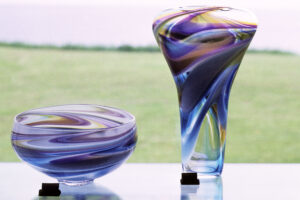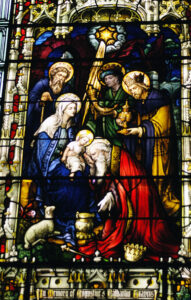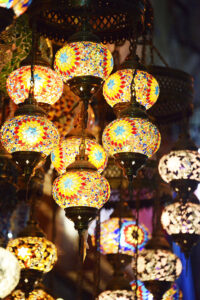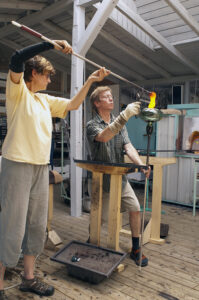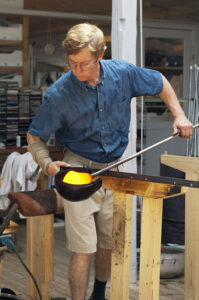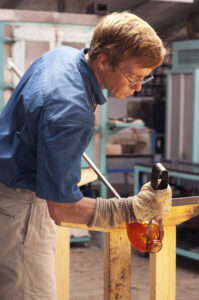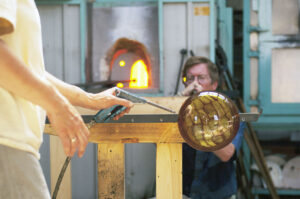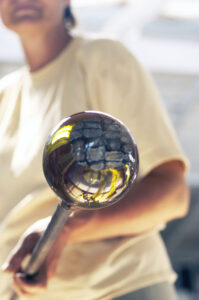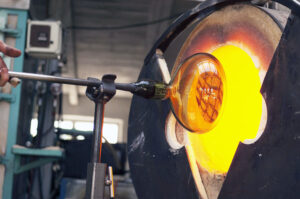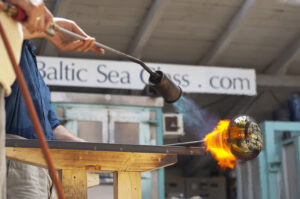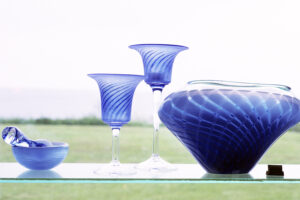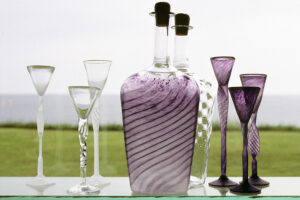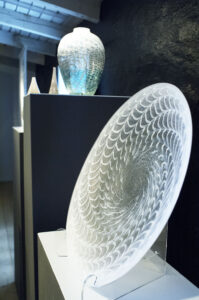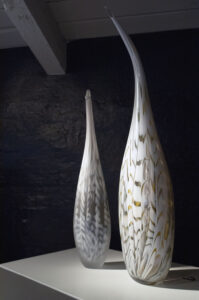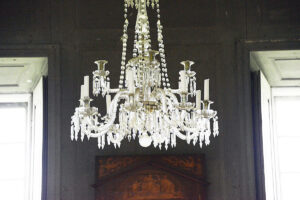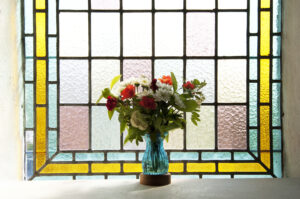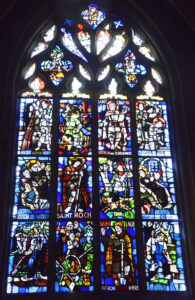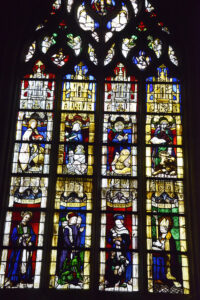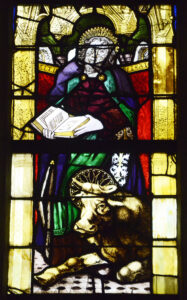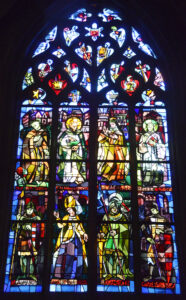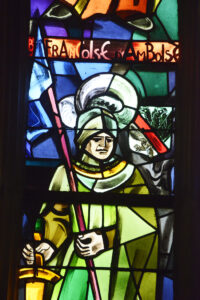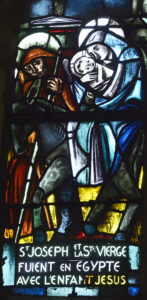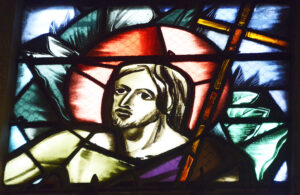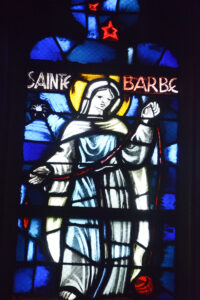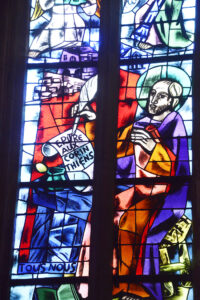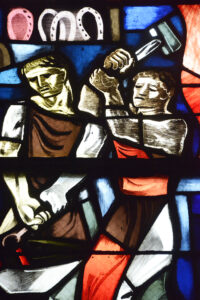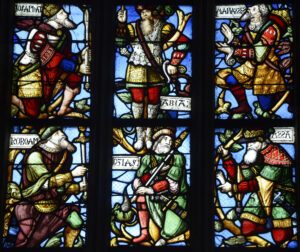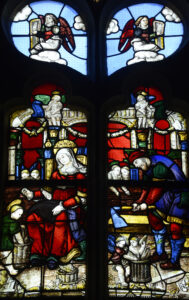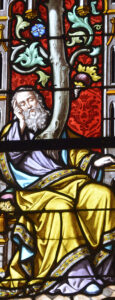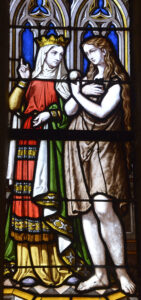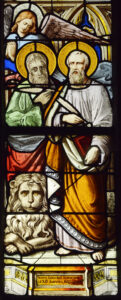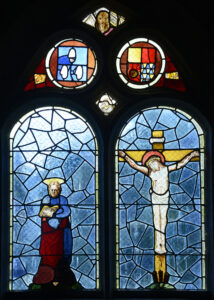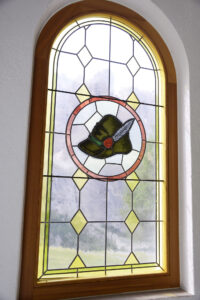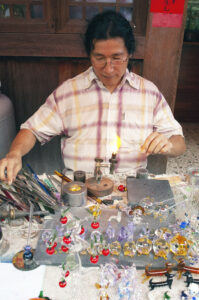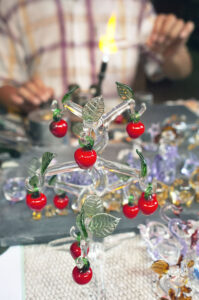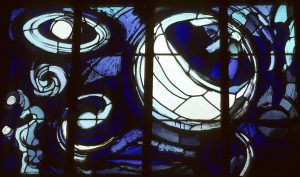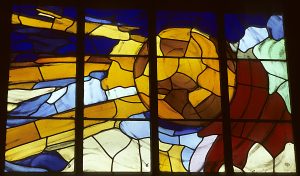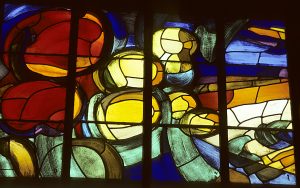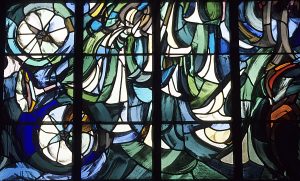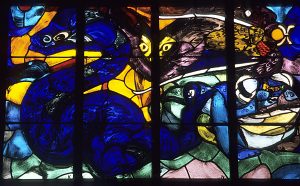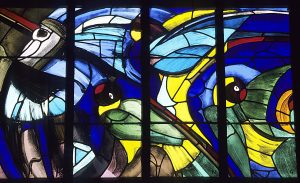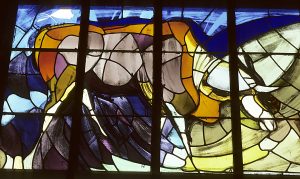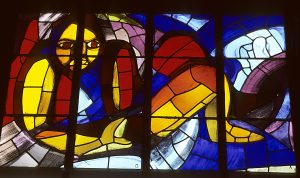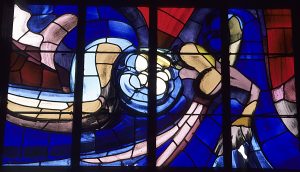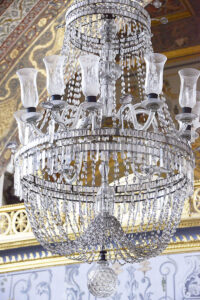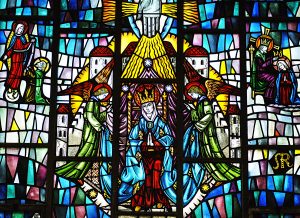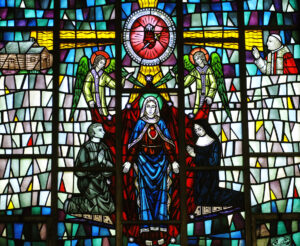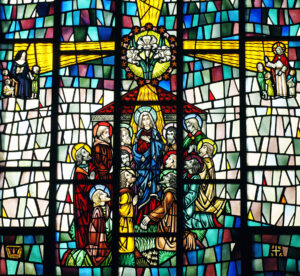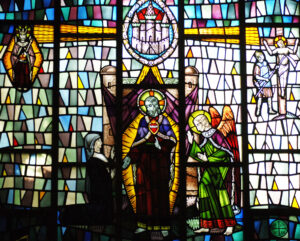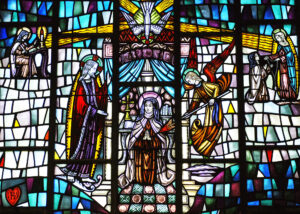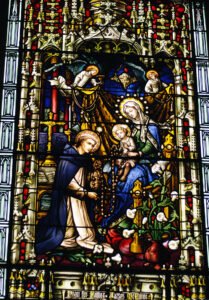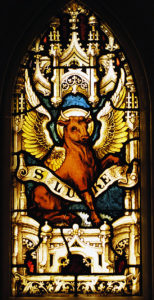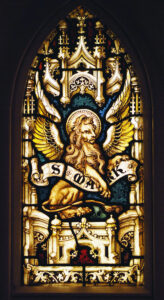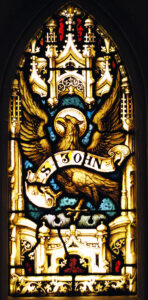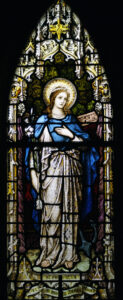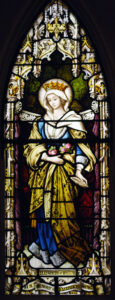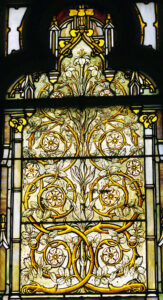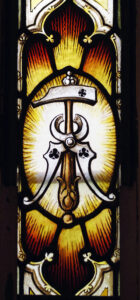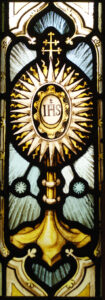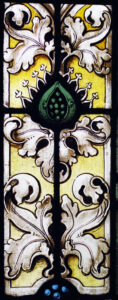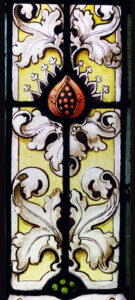Glass art
Glass art, produced at Baltic Sea Glass, Bornholm, Denmark. (Photo copyright © by Kaj Halberg)
Stained-glass window, depicting Virgin Mary, Joseph, and the Three Wise Men, gathered around the infant Jesus. According to legend, one of the wise men was coloured. Above them is the Star of Bethlehem. – St. Dominic’s Church, Oyster Bay, Long Island, New York State. (Photo copyright © by Kaj Halberg)
Colourful lamps for sale in Kapalı Çarşı (‘Covered Market’), also called Büyük Çarşı (‘Grand Bazaar’), Istanbul, Turkey. (Photo copyright © by Kaj Halberg)
A number of stained-glass windows in a tiny church in the village of Rondo, southern Tanzania, depict God’s creations, in this case a leopard (Panthera pardus). (Photo copyright © by Kaj Halberg)
Glassblowing evolved around the 1st Century B.C. It is a technique where you form molten glass by blowing air into it with the aid of a blowpipe.
Stained glass is glass, which has been coloured by adding metallic salts, and then often further decorating it in various ways. The coloured glass has traditionally been used to create stained-glass windows, in which small pieces of glass are arranged to form patterns or pictures, usually held together by strips of lead, and supported by a frame. Painted details and yellow stain are often used to enhance the design. The term stained glass also includes glass, onto which the colours have been painted and then fused to the glass in a kiln.
Stained-glass windows are abundant in Catholic churches, but may also be seen a few other places.
The pictures below are arranged alphabetically according to country name.
Austria
According to an ancient Christian legend, a giant made a living by carrying people across a river. One day, a little boy called him to be carried across. The giant put the child on his shoulders, grabbed his staff, and entered the river. As he was approaching the opposite shore, his burden felt heavier and heavier. The giant leaned heavily on his staff, staggering on, while he was wondering how a little child could be so heavy. With a huge effort, he dragged himself ashore, setting down the child, who said: “I am Christ, and on your back you have just carried all the sins of humankind.”
From that day, the giant was called Christopher, from the Greek Christoforos (’Christ Bearer’). Later, he was sanctified, becoming the protector of wayfarers.
The legend of Saint Christopher, depicted in a stained-glass window in a mountain chapel, Sölk Pass. (Photo copyright © by Kaj Halberg)
Denmark
Baltic Sea Glass, Melsted, Bornholm, was started around 1980 by glass blowing artists Maibritt Jönsson and Pete Hunner. Together, they ran the business for about 40 years, before handing over the company to artists Michael Brandt and Jan Engelbrecht in 2020.
Artists Maibritt Jönsson and Pete Hunner, producing glass art, Baltic Sea Glass. A final touch is made with a bunsen burner. (Photos copyright © by Kaj Halberg)
Completed artwork, Baltic Sea Glass. (Photos copyright © by Kaj Halberg)
The decor on this glass art was inspired by feathers of a pheasant (Phasianus colchicus), Baltic Sea Glass. (Photos copyright © by Kaj Halberg)
Crystal chandelier, dating from the 1700s, Selsø Castle, Zealand. (Photo copyright © by Kaj Halberg)
Flowers and stained-glass window, Sønderho Church, Fanø, western Jutland. (Photo copyright © by Kaj Halberg)
France
The Basilique Saint-Sauveur in Dinan, Brittany, was founded as a Romanesque church in the 11th Century. Parts of the church were rebuilt around 1480, and only the southern nave wall and the lower façade remain from the Romanesque church.
The church became a site of worship of Virgin Mary due to the presence of Notre-Dame-des-Vertus, a bas-relief from the 15th Century, which was formerly in the Fransiscan convent in town. Local veneration of this depiction of the Assumption of the Virgin led to the building being designated as a basilica by Pope Pius XII in 1954.
The basilica houses an abundance of stained-glass windows, many examples of which are shown below.
Various saints. (Photos copyright © by Kaj Halberg)
Detail of the window above. (Photo copyright © by Kaj Halberg)
Various prominent Catholic persons. (Photo copyright © by Kaj Halberg)
Detail of the window above. (Photo copyright © by Kaj Halberg)
Joseph and Virgin Mary, fleeing to Egypt with the infant Jesus. (Photo copyright © by Kaj Halberg)
Jesus, carrying his cross on the way to Golgatha. (Photo copyright © by Kaj Halberg)
According to legend, Saint Barbara was the daughter of a rich pagan, living in the 3rd Century. Her father kept her locked up in a tower in order to protect her from the influence of the outside world. However, she secretly became a Christian and rejected to marry the man her father presented to her.
Before going on a journey, her father ordered a private bath-house to be constructed for her near her dwelling, but during his absence, Barbara had three windows put in it, as a symbol of the Holy Trinity, instead of the two originally intended. When her father returned, she informed him that she had become a Christian. He dragged her before the prefect of the province, but, despite being cruelly tortured, she held true to her Christian faith.
At night, her prison was bathed in light, and every morning her wounds were healed. Torches that were held near her to burn her were extinguished. Finally, she was beheaded, and her father himself carried out the death sentence. As punishment, he was struck by lightning and his body consumed by flame.
Barbara was buried by a Christian, and her tomb became the site of miracles. In his book Reisebeschreibung nach Arabien und andern umliegenden Ländern (Gloyer und Oldshausen, Hamburg, 1837, in English Travels Through Arabia and Other Countries in the East, Performed by M. Niebuhr, Gale Ecco, 2018), German cartographer and mathematician Carsten Niebuhr relates that he was shown her grave in the church of the village Karmelis, near Mosul, northern Iraq, in 1766. Some nearby ruins were said to have been her father’s palace.
Saint Barbara, Basilique Saint-Sauveur, Dinan. (Photo copyright © by Kaj Halberg)
Scribe at work, Basilique Saint-Sauveur, Dinan. (Photo copyright © by Kaj Halberg)
Blacksmiths at work, Basilique Saint-Sauveur, Dinan. (Photo copyright © by Kaj Halberg)
Notre Dame de Confort was built between 1528 and 1544 as a pilgrimage chapel, located in the town of Confort-Meilars, Brittany. It became a parish church in 1910 and was classified as a historic monument in 1914.
Stained-glass windows in Notre Dame de Confort. (Photos copyright © by Kaj Halberg)
Notre Dame de Roscudon in Pont-Croix, Brittany, was founded in the 1200s. It is a historic monument.
Stained-glass windows in Notre Dame de Roscudon. (Photos copyright © by Kaj Halberg)
This stained-glass window in the chapel at the castle in Rochefort en Terre, Bretagne, depicts the crucified Christ. (Photo copyright © by Kaj Halberg)
This one in the same building depicts Virgin Mary with the infant Jesus. (Photo copyright © by Kaj Halberg)
Italy
This stained-glass window in a diminutive church at Passo Gardena, Dolomites, depicts an Alpine hat with rhododendron flowers and a feather. (Photo copyright © by Kaj Halberg)
Taiwan
This man produces glass art, melting the various parts together by using a bunsen burner, Lugang. (Photos copyright © by Kaj Halberg)
Tanzania
The tiny church in the village of Rondo, southern Tanzania, is adorned with a series of gorgeous stained-glass windows, depicting God’s creations, made by English artist and biologist Jonathan Kingdon.
The galaxies. (Photo copyright © by Kaj Halberg)
The sun. (Photo copyright © by Kaj Halberg)
The planets. (Photo copyright © by Kaj Halberg)
Plants, represented by angel’s trumpet (Brugmansia suaveolens). (Photo copyright © by Kaj Halberg)
Amphibians and reptiles. (Photo copyright © by Kaj Halberg)
Birds, represented by yellow-collared lovebird (Agapornis personata) and brown-hooded kingfisher (Halcyon albiventris). (Photo copyright © by Kaj Halberg)
Mammals, represented by an eland antelope (Taurotragus oryx). See also top of the page. (Photo copyright © by Kaj Halberg)
Adam and the pregnant Eve. (Photos copyright © by Kaj Halberg)
Turkey
One of Christendom’s most gorgeous buildings is the Byzantine church ‘Church of the Holy Wisdom’ in Istanbul, Turkey, usually called Hagia Sophia, or, in Turkish, Aya Sofia. This grand structure, which was erected 532-537 during the reign of Roman Emperor Justinian, was converted into a mosque in 1453, and today it is a museum.
The rise of Christianity is described on the page Religion: Christianity.
Crystal chandelier, adorning the Hagia Sophia. (Photo copyright © by Kaj Halberg)
United States
In 1878, a group of Catholic sisters, who called themselves Sisters, Servants of the Immaculate Heart of Mary, arrived at Scranton, Pennsylvania, where they established St. Cecilia’s Academy ‘for young ladies’. In 1902, they opened Mount St. Mary’s Seminary. (The term seminary was roughly equivalent to a high school today.) In 1915, Marywood University, a Catholic liberal arts university, was established.
The following 6 pictures were taken in Our Lady of Lourdes Chapel, the centre chapel of Marywood University, depicting stained-glass windows, created in 1962.
Virgin Mary, called the Queen of Heaven. The hand above her is the Hand of God. The small image to the left depicts a legend, in which Mary hands her cincture to the apostle Thomas, as she is assumed into Heaven. The small image to the right shows the crowning of Mary, and beneath is her monogram. (Photo copyright © by Kaj Halberg)
This window is called Immaculate Heart of Mary. The red symbol above is the seal of the Congregation of Immaculate Heart of Mary. On either side of Virgin Mary are the founders of the congregation, Father Louis Florent Gillet and Mother Theresa Maxis Duchemin. The pope is John XXIII. (Photo copyright © by Kaj Halberg)
This is called Virgin Mary, Queen of the Apostles, which surround her. The upper left figure shows a sister from Immaculate Heart of Mary, teaching children, whereas the upper right figure shows Jesus, teaching children. (Photo copyright © by Kaj Halberg)
This window shows Jesus, presenting the Sacred Heart to Saint Margaret Mary Alacoque. Above Jesus is Jerusalem, the Holy City. The upper left figure shows Jesus as a king, whereas the upper right figure shows a Roman soldier, piercing Jesus with a spear. (Photo copyright © by Kaj Halberg)
In this window, Jesus is knocking on the Door of Souls. Above him is the Golden Ladder to Heaven. The upper left figure shows the parable of the rich young man, the upper right figure the five wise virgins. (Photo copyright © by Kaj Halberg)
This window shows Saint Teresa of Avila, who is kneeling in the centre, as an angel pierces her heart with the love of God. Above Teresa is the Holy Spirit, in the shape of a dove. Upper left panel shows Teresa, working on her writings, and the upper right one shows Virgin Mary, presenting a rosary to Teresa. (Photo copyright © by Kaj Halberg)
St. Dominic’s Church in Oyster Bay, Long Island, New York State, is a Gothic style granite building, which was inaugurated in 1897. Its construction had been no easy task. Besides the many loads of giant timbers needed for the vaulted ceiling, huge granite blocks quarried in Greenwich, Connecticut, had to be transported by barge across Long Island Sound and then hauled by horse-drawn sledge up the hill – the highest point in Oyster Bay.
The following pictures all show stained-glass windows in St. Dominic’s Church.
Virgin Mary, Joseph, and the infant Jesus. (Photo copyright © by Kaj Halberg)
Saint Matthew, the evangelist. (Photo copyright © by Kaj Halberg)
Saint Luke, the evangelist, represented by a winged ox. (Photo copyright © by Kaj Halberg)
Saint Mark, the evangelist, represented by a winged lion. (Photo copyright © by Kaj Halberg)
Saint John, the evangelist, represented by an eagle. (Photos copyright © by Kaj Halberg)
Saint Philomena. (Photo copyright © by Kaj Halberg)
Saint James. (Photo copyright © by Kaj Halberg)
Saint Elizabeth of Hungary. (Photo copyright © by Kaj Halberg)
Saint Benedicta. (Photo copyright © by Kaj Halberg)
Floral ornaments. (Photo copyright © by Kaj Halberg)
This window shows nails, symbolizing the nails used at the Crucifixion of Christ. (Photo copyright © by Kaj Halberg)
Hammer and plier, symbolizing the tools used at the Crucifixion of Christ. (Photo copyright © by Kaj Halberg)
In Latin, the letters IHS stand for Iesus Hominum Salvator (Jesus, Saviour of Humankind). a traditional symbol of Christ. (Photo copyright © by Kaj Halberg)
Leaf ornaments. (Photos copyright © by Kaj Halberg)
(Uploaded July 2024)
(Latest update November 2024)
